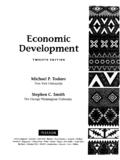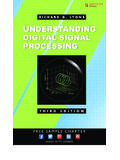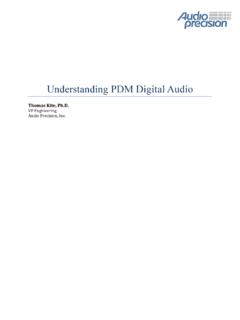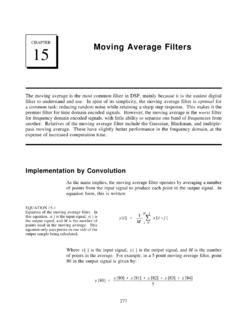Transcription of Understanding Digital Signal Processing - GBV
1 Understanding Digital Signal Processing Richard G. Lyons ^ PRSNTICE HALL PTR PRENTICE HALL Professional Technical Reference Upper Soddle River, New Jersey 07458 Contents Preface xi 1 DISCRETE SEQUENCES AND SYSTEMS 1 Discrete Sequences and Their Notation 2 Signal Amplitude, Magnitude, Power 8 Signal Processing Operational Symbols 9 Introduction to Discrete Linear Time-Invariant Systems 12 Discrete Linear Systems 12 Time-Invariant Systems 17 The Commutative Property of Linear Time-Invariant Systems 18 Analyzing Linear Time-Invariant Systems 19 2 PERIODIC SAMPLING 21 Aliasing.
2 Signal Ambiquity in the Frequency Domain 21 Sampling Low-Pass Signals 26 Sampling Bandpass Signals 30 Spectral Inversion in Bandpass Sampling 39 3 THE DISCRETE FOURIER TRANSFORM 45 Und erstand ing the DFT Equation 46 DFT Symmetry 58 v vi Contents DFT Linearity 60 DFT Magnitudes 61 DFT Frequency Axis 62 DFT Shifting Theorem 63 Inverse DFT 65 DFT Leakage 66 Windows 74 DFT Scalloping Loss 82 DFT Resolution, Zero Padding, and Frequency-Domain Sampling 83 DFT Processing Gain 88 The DFT of Rectangular Functions 91 The DFT Frequency Response to a Complex Input 112 The DFT Frequency Response to a Real Cosine Input 116 The DFT Single-Bin Frequency Response to a Real Cosine Input 117 Interpreting the DFT 120 4 THE FAST FOURIER TRANSFORM 125 Relationship of the FFT to the DFT 126 Hints on Using FFTs in Practice 127 FFT Software Programs 131 Derivation of the Radix-2 FFT Algorithm 132 FFT Input/Output Data Index Bit Reversal 139 Radix-2 FFT Butterfly Structures 141 5 FINITE IMPULSE RESPONSE FILTERS
3 151 An Introduction to Finite Impulse Response FIR Filters 152 Convolution in FIR Filters 157 Low-Pass FIR Filter Design 167 Bandpass FIR Filter Design 183 Highpass FIR Filter Design 184 Remez Exchange FIR Filter Design Method 186 Half-Band FIR Filters 188 vii Phase Response of FIR Filters 190 A Generic Description of Discrete Convolution 195 6 INFINITE IMPULSE RESPONSE FILTERS 211 An Introduction to Infinite Impulse Response Filters 212 The Laplace Transform 215 The z-Transform 228 Impulse Invariance HR Filter Design Method 243 Bilinear Transform HR Filter Design Method 259 Optimized HR Filter Design Method 270 Pitfalls in Building HR Digital Filters 272 Improving HR Filters with Cascaded Structures 274 A Brief Comparison of HR and FIR Filters 279 7 SPECIALIZED LOWPASS FIR FILTERS 283 Frequency Sampling Filters.
4 The Lost Art 284 Interpolated Lowpass FIR Filters 319 8 QUADRATURE SIGNALS 335 Why Care About Quadrature Signals 336 The Notation of Complex Numbers 336 Representing Real Signals Using Complex Phasors 342 A Few Thoughts on Negative Frequency 346 Quadrature Signals in the Frequency Domain 347 Bandpass Quadrature Signals in the Frequency Domain 350 Complex Down-Conversion 352 A Complex Down-Conversion Example 354 An Alternate Down-Conversion Method 358 9 THE DISCRETE HILBERT TRANSFORM 361 Hubert Transform Definition 362 Why Care About the Hubert Transform?
5 364 Impulse Response of a Hubert Transformer 369 vill Contents Designing a Discrete Hilbert Transformer 371 Time-Domain Analytic Signal Generation 377 Comparing Analytical Signal Generation Methods 379 10 SAMPLE RATE CONVERSION 381 Decimation 382 Interpolation 387 Combining Decimation and Interpolation 389 Polyphase Filters 391 Cascaded Integrator-Comb Filters 397 11 Signal AVERAGING 411 Coherent Averaging 412 Incoherent Averaging 419 Averaging Multiple Fast Fourier Transforms 422 Filtering Aspects of Time-Domain Averaging 430 Exponential Averaging 432 12 Digital DATA FORMATS AND THEIR EFFECTS 439 Fixed-Point Binary Formats 439 Binary Number Precision and Dynamic Range 445 Effects of Finite Fixed-Point Binary Word Length 446 Floating-Point Binary Formats 462 Block Floating-Point Binary Format 468 13 Digital Signal Processing TRICKS 471 Frequency Translation without Multiplication 471 High-Speed Vector-Magnitude Approximation 479 Frequency-Domain Windowing 484 Fast Multiplication of Complex Numbers 487
6 Efficiently Performing the FFT of Real Sequences 488 Computing the Inverse FFT Using the Forward FFT 500 Simplified FIR Filter Structure 503 Reducing A/D Converter Quantization Noise 503 Contents jX A/D Converter Testing Techniques 510 Fast FIR Filtering Using the FFT 515 Generating Normally Distributed Random Data 516 Zero-Phase Filtering 518 Sharpened FIR Filters 519 Interpolating a Bandpass Signal 521 Spectral Peak Location Algorithm 523 Computing FFT Twiddle Factors 525 Single Tone Detection 528 The Sliding DFT 532 The Zoom FFT 541 A Practical Spectrum Analyzer 544 AnEfficient Arctangent Approximation 547 Frequency Demodulation Algorithms 549 DC Removal 552 Improving Traditional CIC Filters 556 Smoothing Impulsive Noise 561 Efficient Polynomial Evaluation 563 Designing Very High-Order FIR Filters 564 Time-Domain Interpolation Using the FFT 568 Frequency Translation Using Decimation 571 Automatic Gain Control (AGC) 571 Approximate Envelope Detection 574 A Quadrature Oscillator 576 Dual-Mode Averaging 578 APPENDIX A.
7 THE ARITHMETIC OF COMPLEX NUMBERS 585 Graphical Representation of Real and Complex Numbers 585 Arithmetic Representation of Complex Numbers 586 Arithmetic Operations of Complex Numbers 588 Some Practical ImplicationsofUsing Complex Numbers 593 APPENDIX B. CLOSED FORM OF A GEOMETRIC SERIES 595 APPENDIX C. TIME REVERSAL AND THE DFT 599 X Contents APPENDIX D. MEAN, VARIANCE, AND STANDARD DEVIATION 603 Statistical Measures 603 Standard Deviation, or RMS, of a Continuous Sinewave 606 The Mean and Variance of Random Functions 607 The Normal Probability Density Function 610 APPENDIX E. DECIBELS (DB AND DBM) 613 Using Logarithms to Determine Relative Signal Power 613 Some Useful Decibel Numbers 617 Absolute Power Using Decibels 619 APPENDIX F.
8 Digital FILTER TERMINOLOGY 621 APPENDIX G. FREQUENCY SAMPUNG FILTER DERIVATIONS 633 Frequency Response of a Comb Filter 633 Single Complex FSF Frequency Response 634 Multisection Complex FSF Phase 635 Multisection Complex FSF Frequency Response 636 Real FSF Transfer Function 638 Type-IV FSF Frequency Response 640 APPENDIX H. FREQUENCY SAMPLING FILTER DESIGN TABLES 643 INDEX 657 ABOUT THE AUTHOR 667



















